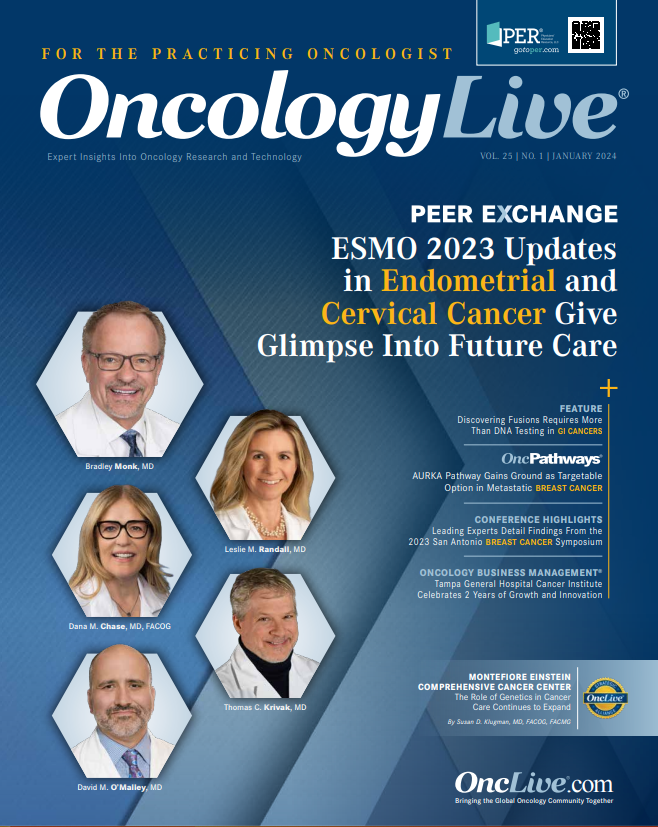Publication
Article
Oncology Live®
AURKA Pathway Gains Ground as Targetable Option in Metastatic Breast Cancer
Author(s):
As novel drugs targeting the AURKA pathway continue to advance through the development pipeline, alisertib has emerged as an agent of particular note.
Tufia C. Haddad, MD

As novel drugs targeting the Aurora A kinase (AURKA) pathway continue to advance through the development pipeline, the AURKA inhibitor alisertib (MLN8237) has emerged as an agent of particular note, demonstrating early signals of efficacy with a manageable safety profile for the treatment of patients with locally advanced or metastatic breast cancer whose disease is resistant to endocrine therapies.1
“Patients with estrogen receptor [ER]-positive metastatic breast cancer will inevitably develop resistance to first-line endocrine therapies, and AURKA upregulation is one of the mechanisms of acquired resistance to CDK4/6 inhibitors,” Karthik V. Giridhar, MD, an oncologist specializing in breast cancer at Mayo Clinic in Rochester, Minnesota, said in an interview with OncologyLive®. “We truly need drugs to help target this pathway in the clinic.”
“[The] AURKA pathway is a novel pathway that has been understudied in breast cancer,” Tufia C. Haddad, MD, said in an interview with OncologyLive. “[Alisertib has] shown very significant clinical activity in a clinical setting for which we have no standard-of-care [SOC] therapies at the present time, which is after progression on a CDK4/6 inhibitor and endocrine therapy.”
Haddad, an associate professor of oncology at Mayo Clinic College of Medicine and Science, chair of practice innovation and platform at Mayo Clinic Comprehensive Cancer Center, and medical director of Care at Home in the Center for Digital Health, explained that alisertib was initially developed as an antimitotic agent to inhibit the cell cycle. Therefore, the agent has chemotherapy-like properties and inhibits the cell cycle through a targeted approach for a specific mitotic kinase.
Targeting Aurora Kinases
The Aurora kinases—A, B, and C— are isoform serine/threonine kinases that regulate mitosis and meiosis.2 AURKA is located within the region of chromosome 20q13.2, and Aurora B kinase is in the region of chromosome 17p13.3 Additionally, AURKA is highly expressed in small cell lung cancer (SCLC).4
Activation of AURKA is associated with downregulation of ERα expression, endocrine resistance, and it is implicated in CDK4/6 inhibitor resistance. Preclinical metastatic breast cancer models have shown that alisertib upregulates ERα and restores endocrine sensitivity.1
“Alisertib targeting this novel AURKA pathway is a potential unmet need that could be fulfilled,” Haddad said. “One step beyond that [is] because alisertib is targeting these cells that have stem cell–like properties, by eradicating the stem cells there could potentially be better therapeutic activity with alisertib relative to drugs that target other pathways of endocrine resistance. Some of that head-to-head evaluation certainly needs to occur both preclinically and clinically before we can draw any conclusions on that, but we’re excited about that potential.”
Haddad and Giridhar detailed findings from Mayo Clinic Comprehensive Cancer Center colleague Antonio D’Assoro, MD, PhD, who is an assistant professor of biochemistry and molecular biology and an associate professor of pharmacology.
“My preclinical collaborator in the laboratory, Dr Antonio D’Assoro discovered a novel nonmitotic action and role for AURKA,” Haddad said. “He showed in the laboratory that when AURKA is activated it stimulates the epithelial-mesenchymal transition [EMT] in breast cancer cells. Specifically, when you take luminal ER-positive breast cancer cells that are sensitive to endocrine therapy when AURKA is activated in this setting, these cells undergo EMT reprogramming, and the clonal propagation of these cells that have stem cell–like features—so they’re more basal, lose their ER expression, become resistant to endocrine therapy, and have enhanced metastatic potential. Alisertib aims to block AURKA potentially in both its mitotic properties as well as these nonmitotic properties with that activation of EMT reprogramming.”
Giridhar added, “Dr D’Assoro helped identify that treatment with the AURKA inhibitor alisertib helped to restore that epithelial phenotype and potentially resensitize the endocrine therapy. That background helped set the stage for the phase 2 TBCRC041 study [NCT02860000] study.”
Alisertib Demonstrates Efficacy in Advanced Breast Cancer
The TBCRC041 trial evaluated alisertib as monotherapy and in combination with fulvestrant (Faslodex) in patients with locally advanced or metastatic breast cancer resistant to endocrine therapies. Findings from the trial revealed that the AURKA inhibitor had a manageable safety profile and displayed promising clinical activity as monotherapy. However, treatment with the doublet did not increase objective response rates (ORRs) or progression-free survival (PFS) compared with alisertib alone. Haddad noted that the rationale for combining the agents was to restore sensitivity; alisertibwould restore the sensitivity to endocrine therapy, and then fulvestrant could be added to treatment.1
“All patients who participated in this clinical trial had advanced metastatic breast cancer that, even though it was ER-positive, had become resistant to endocrine therapy; all received prior fulvestrant and their tumors had become resistant to fulvestrant; and all received CDK4/6 inhibitors because that had become the SOC during this the course of this clinical trial,” Haddad, who was also the study’s lead author, explained. “Additionally, 58.2% of patients had received prior chemotherapy as well. These were patients who had seen a lot of prior therapies.”
The ORR for patients in the monotherapy arm (n = 46) was 19.6% (90% CI, 10.6%-31.7%), comprised of all partial responses (PRs), compared with 20.0% (90% CI, 10.9%- 32.3%) for patients treated with alisertib plus fulvestrant (n = 45), which included 1 complete response and 8 PRs.1
The median duration of response (DOR) was 15.1 months in the monotherapy arm, and the 24-week clinical benefit rate (CBR) was 41.3% (90% CI, 29.0%-54.5%). The estimated median PFS was 5.6 months (95% CI, 3.9-10.0), and the 1-year overall survival (OS) rate was 75.1% (95% CI, 63.4%-89.0%). Patients in the combination arm experienced a median DOR of 8.5 months, a 24-week CBR of 28.9% (90% CI, 18.0%-42.0%), an estimated median PFS of 5.4 months (95% CI, 3.9-7.8), and a 1-year OS rate of 62.7% (95% CI, 49.7%-79.0%).1
“It is very encouraging that there was a sizeable proportion of patients who were durable responders,” Giridhar said.
Regarding safety, a single grade 5 respiratory failure event occurred in a patient receiving the doublet. The most common grade 2 treatment-related adverse effects (AEs) that occurred in the monotherapy and combination therapy arms were alopecia (41% and 40%, respectively), decreased white blood cell count (28% and 18%), fatigue (24% and 29%), anemia (22% and 22%), and decreased neutrophil count (15% and 13%). Decreased neutrophil count was the most common grade 3 (24% and 20%) and grade 4 event (17% and 22%), respectively. Additional grade 4 events in the monotherapy and combination therapy arms included decreased white blood cell count (4% and 9%) and decreased platelet count (2% and 2%); in the monotherapy arm anemia, febrile neutropenia, acute coronary syndrome, and thrombotic microangiopathic hemolysis occurred in 1 patient each.1
Giridhar noted that “with the pulse dosing [in this study] we saw fewer issues with mucositis and some of the hematologic toxicities than we [have] seen with the continuous dosing schedules. The pulse dosing schedule was very well tolerated. Alisertib was given on days 1 to 3, 8 to 10, and 15 to 17 on a 28-day cycle. Otherwise, there is a continuous weekly schedule [that has been used in other studies with alisertib] with 1 week on, 2 weeks off—you have to give a couple of weeks off due to the hematologic AEs.”
“The drug was well tolerated,” Haddad added. “Approximately one-third of patients required a dose reduction, and [approximately] 10% of patients [in the monotherapy arm] stopped participation in the trial due to toxicities as opposed to progression of their cancer. We saw a favorable safety profile.”
Evaluations of AURKA in Several Tumor Types
Findings from a phase 1/2 study (NCT01045421) that examined alisertib monotherapy showed that among evaluable patients with breast cancer (n = 49), SCLC (n = 48), non–small cell lung cancer (n = 23), head and neck squamous cell carcinoma (n = 45), and gastroesophageal adenocarcinoma (n = 47), ORRs were 18% (95% CI, 9%-32%), 21% (95% CI, 10%-35%), 4% (95% CI, 0%-22%), 9% (95% CI, 2%-21%), and 9% (95% CI, 2%-20%), respectively. Alisertib 50 mg was given twice daily for 7 days in 21-day cycles. The most common any-grade AEs in the overall population (n = 249) were fatigue (42%), alopecia (39%), diarrhea (35%), nausea (31%), and anemia (27%). The most prevalent grade 3/4 events were neutropenia (44%), leukopenia (22%), and anemia (16%).6
“This pathway is also being evaluated in triple-negative breast cancer,” Haddad said. “We’re just scratching the surface for how alisertib can have activity not just in endocrine-resistant breast cancer, but also across other molecular subtypes.”
Further, data presented at the 2023 American Society of Clinical Oncology Annual Meeting regarding the selective, reversible, small molecule AURKA inhibitor VIC-1911 revealed that the agent demonstrated preclinical activity as monotherapy and as combination therapy with the KRAS G12C inhibitor sotorasib (Lumakras).7 Investigators concluded that the preclinical findings supported further evaluation of the agent plus sotorasib in treatment-naive KRAS G12C-mutated NSCLC; however, a phase 1a/1b study (NCT05374538) evaluating the combination therapy in patients with locally advanced or metastatic KRAS G12C-mutated NSCLC was terminated, cited as sponsor decision.8
“Some of the additional work that is ongoing is looking at other approaches with different endocrine agents,” Haddad noted. “Also, now that we have the emergence of the oral selective estrogen receptor degraders, [we are] looking at other endocrine therapy backbones for alisertib combinations to see if we can improve upon some of the initial results we’ve seen thus far.”
Further combinations are under consideration as a study published in Cell Death & Disease revealed that the combination of alisertib and the kinase inhibitor sorafenib (Nexavar) may be a promising treatment for patients with aggressive thyroid carcinoma. A synergistic effect between alisertib and sorafenib in anaplastic thyroid carcinoma and differentiated thyroid cancer was confirmed in xenograft models and in vitro.9
Looking to the Future of Aurora Kinase Inhibitors
In September 2023, alisertib was granted orphan drug designation by the FDA for the treatment of patients with extensive-stage SCLC based on data from the phase 1/2 alisertib monotherapy study of patients with advanced solid tumors.10
Additionally, the phase 2 PUMA-ALI-4201 trial (NCT06095505) is planning to evaluate alisertib monotherapy at the 50-mg dose in patients with extensive-stage SCLC. The study will enroll patients who experienced disease progression following first-line platinum-based chemotherapy and immunotherapy.11
“Some of the immediate next steps will be focusing on optimization of the dose and schedule of the drug so that we can optimize its efficacy and minimize the toxicities. [We are] focusing initially on optimization of dose and schedule, in anticipation of moving the drug forward for additional efficacy [evaluation], clinical trials, and [evaluation] against some of our current SOC therapies,” Haddad said.
Additionally, Giridhar highlighted that correlative analyses will take place following the TBCRC041 study. “On TBCRC041 there are some robust correlatives. Patient blood samples and patient tissue metastatic biopsies were collected at multiple time points. Right now, we’re delving into these correlatives, and we are keen on better understanding the biology that is associated with those prolonged responders. We have multiple patient-derived xenograft models that were generated from patients [who] were both sensitive to alisertib and who had intrinsic resistance and acquired resistance to alisertib. There’s going to be a lot of science that comes out of this phase 2 study to help better understand and characterize both the molecular biology and the treatment patterns associated with alisertib response,” Giridhar said.
References
- Haddad TC, Suman VJ, D’Assoro AB, et al. Evaluation of alisertib alone or combined with fulvestrant in patients with endocrine-resistant advanced breast cancer: the phase 2 TBCRC041 randomized clinical trial. JAMA Oncol. 2023;9(6):815-824. doi:10.1001/jamaoncol.2022.7949
- Kovacs AH, Zhao D, Hou J. Aurora B inhibitors as cancer therapeutics. Molecules. 2023;28(8):3385. doi:10.3390/molecules28083385
- Bisht P, Jaswal S, Gupta GD, Verma SK. A comprehension on synthetic strategies of Aurora kinase A and B inhibitors. Journal of Molecular Structure. 2023;1278:134935. doi:10.1016/j.molstruc.2023.134935
- Canova S, Trevisan B, Abbate MI, et al. Novel therapeutic options for small cell lung cancer. Curr Oncol Rep. 2023;25(11):1277-1294. doi:10.1007/s11912-023-01465-7
- Khalafi S, Lockhart AC, Livingstone AS, El-Rifai W. Targeted molecular therapies in the treatment of esophageal adenocarcinoma, are we there yet? Cancers (Basel). 2020;12(11):3077. doi:10.3390/cancers12113077
- Melichar B, Adenis A, Lockhart AC, et al. Safety and activity of alisertib, an investigational aurora kinase A inhibitor, in patients with breast cancer, small-cell lung cancer, non-small-cell lung cancer, head and neck squamous-cell carcinoma, and gastro-oesophageal adenocarcinoma: a five-arm phase 2 study. Lancet Oncol. 2015;16(4):395-405. doi:10.1016/S1470-2045(15)70051-3
- Goldberg SB, Punekar SR, Velcheti V, et al. A phase 1a/1b study of aurora kinase A inhibitor VIC-1911 as monotherapy and in combination with sotorasib for the treatment of KRAS G12C-mutant non–small-cell lung cancer. J Clin Oncol. 2023;41(suppl 16):TPS9140. doi:10.1200/JCO.2023.41.16_suppl.TPS9140
- VIC-1911 monotherapy in combination with sotorasib for the treatment of KRAS G12C-mutant non-small cell lung cancer. ClinicalTrials.gov. Updated September 28, 2023. Accessed December 7, 2023. bit.ly/46XTsYm
- Jingtai Z, Linfei H, Yuyang Q, et al. Targeting Aurora-A inhibits tumor progression and sensitizes thyroid carcinoma to sorafenib by decreasing PFKFB3-mediated glycolysis. Cell Death Dis. 2023;14(3):224. doi:10.1038/s41419-023-05709-z
- Puma Biotechnology receives FDA orphan drug designation for alisertib for the treatment of small cell lung cancer. News release. Puma Biotechnology. September 21, 2023. Accessed December 7, 2023. bit.ly/3R8SZfX
- A study of alisertib in patients with extensive stage small cell lung cancer. ClinicalTrials.gov. Updated October 23, 2023. Accessed December 7, 2023. bit.ly/3Tfs3xI



















%20(2)%201-Recovered-Recovered-Recovered-Recovered-Recovered-Recovered-Recovered-Recovered-Recovered-Recovered-Recovered-Recovered-Recovered-Recovered-Recovered-Recovered-Recovered-Recovered.jpg?fit=crop&auto=format)
%20(2)%201-Recovered-Recovered-Recovered-Recovered-Recovered-Recovered-Recovered-Recovered-Recovered-Recovered-Recovered-Recovered-Recovered-Recovered-Recovered-Recovered-Recovered-Recovered.jpg?fit=crop&auto=format)
